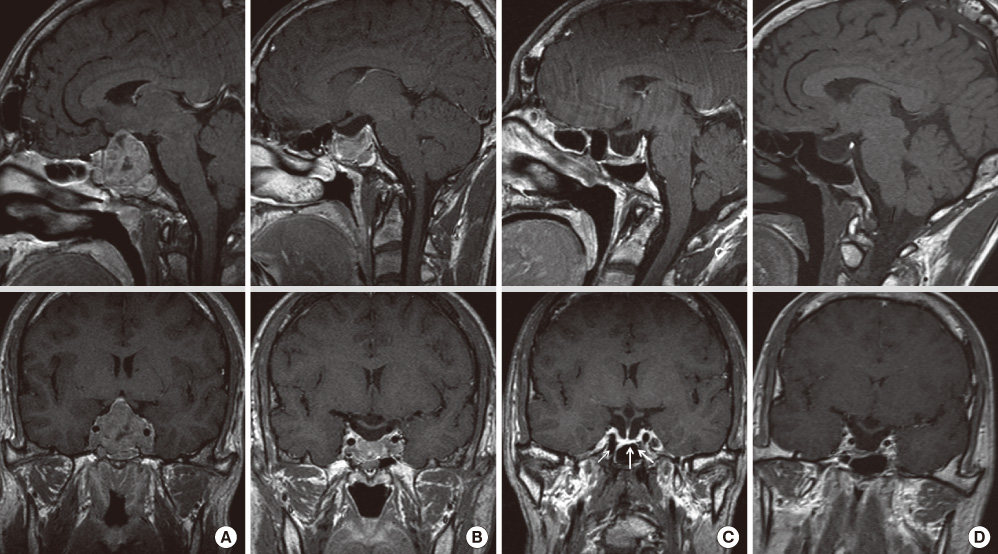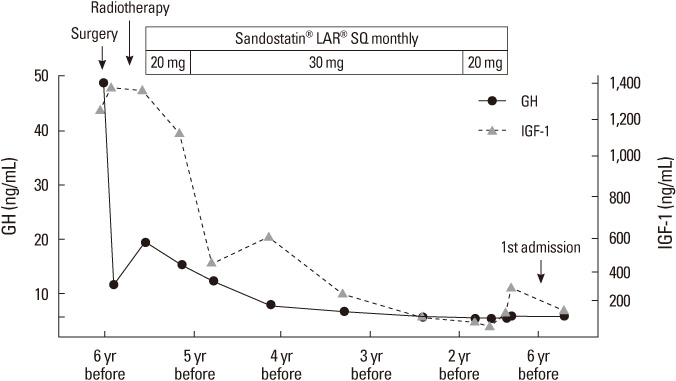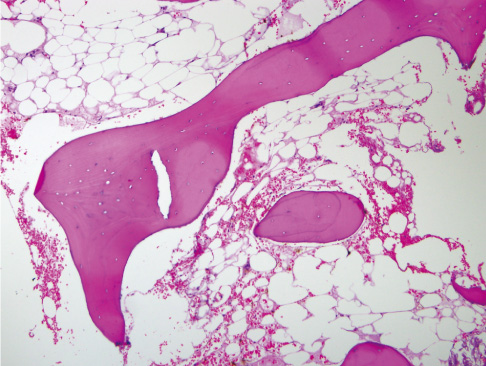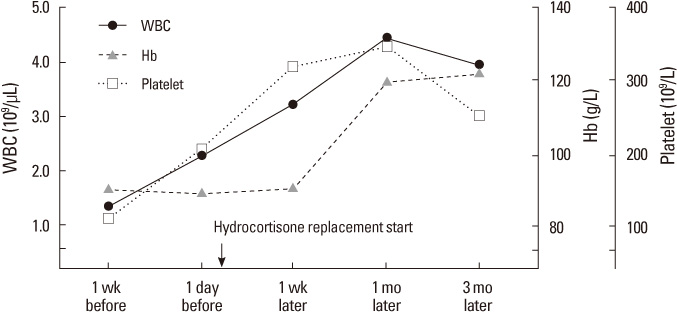Endocrinol Metab.
2012 Dec;27(4):308-313. 10.3803/EnM.2012.27.4.308.
Pancytopenia Associated with Hypopituitarism in an Acromegaly Patient: A Case Report and a Review of the Literature
- Affiliations
-
- 1Department of Internal Medicine, Pusan National University School of Medicine, Busan, Korea. injkim@pusan.ac.kr
- KMID: 1973795
- DOI: http://doi.org/10.3803/EnM.2012.27.4.308
Abstract
- We present the case of a patient with acromegaly who had pancytopenia with hypopituitarism secondary to the excision of a pituitary macroadenoma and radiation therapy. A 28-year-old man presented with pancytopenia and serum electrolyte abnormalities. He was diagnosed with acromegaly and underwent surgery and gamma-knife radiotherapy for a pituitary macroadenoma at the age of 22 years. A recent brain magnetic resonance imaging showed an empty sella, and the basal hormonal profile demonstrated deficiencies of pituitary hormones except thyrotropin. As presenting pancytopenia, his bone marrow biopsy showed hypocellular marrow. The total number of hemocytes increased after hydrocortisone replacement. Hypopituitarism was a possible cause of pancytopenia, and glucocorticoids had crucial effects on converting pancytopenia to normal in this case.
Keyword
MeSH Terms
Figure
Reference
-
1. Holdaway IM, Rajasoorya C. Epidemiology of acromegaly. Pituitary. 1999. 2:29–41.2. Melmed S, Colao A, Barkan A, Molitch M, Grossman AB, Kleinberg D, Clemmons D, Chanson P, Laws E, Schlechte J, Vance ML, Ho K, Giustina A. Acromegaly Consensus Group. Guidelines for acromegaly management: an update. J Clin Endocrinol Metab. 2009. 94:1509–1517.3. Segel GB, Lichtman MA. Kaushansky K, Williams WJ, editors. Aplastic anemia: acquired and inherited. Williams Hematology. 2010. 8th ed. New York: McGraw-Hill Medical;569–590.4. Kim DY, Kim JH, Park YJ, Jung KH, Chung HS, Shin S, Yun SS, Park S, Kim BK. Case of complete recovery of pancytopenia after treatment of hypopituitarism. Ann Hematol. 2004. 83:309–312.5. Ozdogan M, Yazicioglu G, Karadogan I, Cevikol C, Karayalcin U, Undar L. Sheehan's syndrome associated with pancytopenia due to marrow aplasia: full recovery with hormone replacement therapy. Int J Clin Pract. 2004. 58:533–535.6. Gokmen Akoz A, Atmaca H, Ustundag Y, Ozdamar SO. An unusual case of pancytopenia associated with Sheehan's syndrome. Ann Hematol. 2007. 86:307–308.7. Laway BA, Bhat JR, Mir SA, Khan RS, Lone MI, Zargar AH. Sheehan's syndrome with pancytopenia: complete recovery after hormone replacement (case series with review). Ann Hematol. 2010. 89:305–308.8. Laway BA, Mir SA, Bhat JR, Lone MI, Samoon J, Zargar AH. Hematological response of pancytopenia to glucocorticoids in patients with Sheehan's syndrome. Pituitary. 2012. 15:184–187.9. Fatma M, Mouna E, Nabila R, Mouna M, Nadia C, Mohamed A. Sheehan's syndrome with pancytopenia: a case report and review of the literature. J Med Case Rep. 2011. 5:490.10. Holmes GI, Shepherd P, Walker JD. Panhypopituitarism secondary to a macroprolactinoma manifesting with pancytopenia: case report and literature review. Endocr Pract. 2011. 17:e32–e36.11. Badawi MA, Salih F, Al-Humaidi AA, El Khalifa MY, Elhadd TA. Bone marrow hypoplasia responsive to testosterone therapy in a patient with panhypopituitarism: need for adherence to androgen replacement. Endocr Pract. 2008. 14:229–232.12. Lee AC. Pancytopenia secondary to hypopituitarism may just be due to hypothyroidism alone. Ann Hematol. 2010. 89:1181.13. Nishioka H, Haraoka J. Hypopituitarism and anemia: effect of replacement therapy with hydrocortisone and/or levothyroxine. J Endocrinol Invest. 2005. 28:528–533.14. Laway BA, Mir SA, Bashir MI, Bhat JR, Samoon J, Zargar AH. Prevalence of hematological abnormalities in patients with Sheehan's syndrome: response to replacement of glucocorticoids and thyroxine. Pituitary. 2011. 14:39–43.15. Moriyama Y, Fisher JW. Effects of testosterone and erythropoietin on erythroid colony formation in human bone marrow cultures. Blood. 1975. 45:665–670.16. Dainiak N, Hoffman R, Maffei LA, Forget BG. Potentiation of human erythropoiesis in vitro by thyroid hormone. Nature. 1978. 272:260–262.17. Merchav S, Tatarsky I, Hochberg Z. Enhancement of erythropoiesis in vitro by human growth hormone is mediated by insulin-like growth factor I. Br J Haematol. 1988. 70:267–271.18. Sohmiya M, Kato Y. Effect of long-term administration of recombinant human growth hormone (rhGH) on plasma erythropoietin (EPO) and haemoglobin levels in anaemic patients with adult GH deficiency. Clin Endocrinol (Oxf). 2001. 55:749–754.
- Full Text Links
- Actions
-
Cited
- CITED
-
- Close
- Share
- Similar articles
-
- A Case of Pancytopenia Caused by Sheehan's Syndorme Improved with Hormone Replacement Therapy
- An Epidemiologic Study on Pituitary Diseas
- A Case of Sheehan's Syndrome with Pancytopenia
- A Case of Idiopathic Myelofibrosis Associated with Acromegaly Patient
- Characteristics of Acromegaly in Korea with a Literature Review





